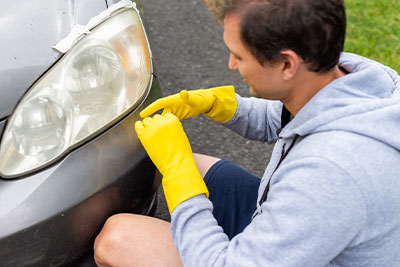Safe Driving: Importance of Clear Headlight

 Headlights are one of the most important safety features on your vehicle. They help ensure you can see the road clearly at night, in bad weather, and during low-visibility conditions. However, over time, headlights can become cloudy, dim, or misaligned, reducing their effectiveness. Keeping your headlights clear and in good working condition is essential for safe driving.
Headlights are one of the most important safety features on your vehicle. They help ensure you can see the road clearly at night, in bad weather, and during low-visibility conditions. However, over time, headlights can become cloudy, dim, or misaligned, reducing their effectiveness. Keeping your headlights clear and in good working condition is essential for safe driving.
Why Clear Headlights Matter
Many drivers don’t realize how much visibility they lose when their headlights become foggy or dim. Here’s why maintaining clear headlights is crucial:
- Improved Visibility: Clear headlights allow you to see obstacles, road signs, and pedestrians more easily, reducing the risk of accidents.
- Better Reaction Time: When you can see the road ahead clearly, you have more time to react to sudden changes in traffic, wildlife crossings, or road debris.
- Increased Safety for Other Drivers: Bright, properly functioning headlights help other drivers see your vehicle, preventing collisions.
- Compliance with the Law: Many states have laws requiring headlights to be in proper working order. Dim or cloudy headlights may result in a ticket or fine.
Common Causes of Headlight Deterioration
Over time, several factors can cause headlights to become less effective:
- Oxidation: The plastic lens on headlights can become cloudy due to UV exposure.
- Dirt and Debris: Dust, road grime, and bugs can accumulate on headlights, dimming their brightness.
- Moisture Buildup: Condensation inside the headlight housing can scatter light and reduce visibility.
- Bulb Wear: Headlight bulbs dim over time, even before they burn out completely.
How to Keep Your Headlights Clear and Bright
Regular maintenance can help ensure your headlights remain effective. Here are a few tips:
Clean Your Headlights Regularly
Wash your headlights when you clean your car. Use a soft cloth, mild soap, and water to remove dirt and grime. For stubborn buildup, use a headlight cleaning solution.
Restore Foggy or Yellowed Lenses
If your headlights look cloudy or yellowed, consider using a headlight restoration kit. These kits include special compounds to remove oxidation and restore clarity.
Check for Moisture Inside the Headlights
Moisture buildup inside the headlight casing can reduce visibility. If you notice condensation, check for cracks or loose seals and repair them as needed.
Replace Dim or Burnt-Out Bulbs
Headlight bulbs weaken over time. If your lights seem dim, replace the bulbs even if they haven’t burned out completely.
Ensure Proper Headlight Alignment
Misaligned headlights can reduce visibility and blind other drivers. If your lights appear too low or high, have them adjusted by a professional.
When to Replace Your Headlights
Even with proper care, headlights will eventually need replacement. Consider replacing your headlights if:
- They remain dim even after cleaning and bulb replacement.
- They are severely cracked or damaged.
- There is persistent moisture buildup inside the headlight casing.
Final Thoughts
Clear and well-functioning headlights are essential for safe driving. Regular cleaning, maintenance, and timely bulb replacements can make a significant difference in your visibility on the road. Keeping your headlights in top condition not only enhances your safety but also ensures you comply with traffic laws.
For more vehicle safety tips and insurance guidance, contact Robins Insurance today.
Disclaimer: The information provided in this blog post is intended for general knowledge and informational purposes only, and does not constitute professional insurance advice. The content is not exhaustive and does not cover all potential situations. It is essential to review your specific insurance policy and discuss your individual circumstances with your insurance agent or broker. We strongly recommend that you consult with a qualified insurance professional to address your insurance needs and questions.
Source link



